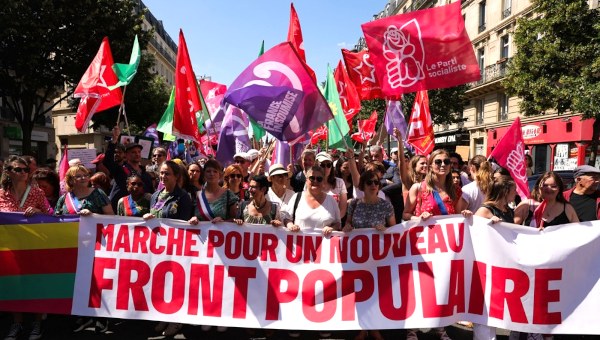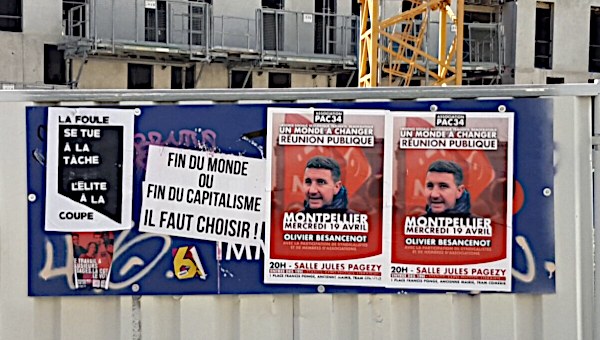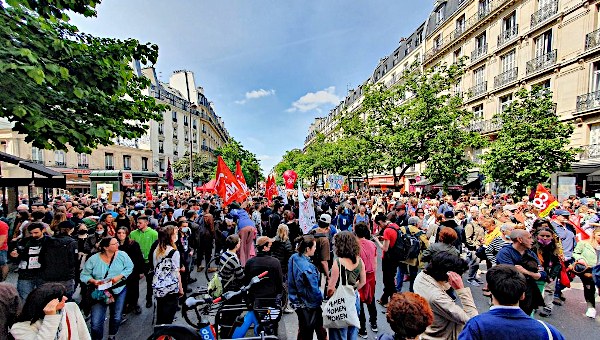An Infernal Dance: The 2022 French Presidential Election
Five years ago, between the first and the second round of the French presidential election, the slogan “Macron 2017 = Le Pen 2022” was easy to spot on walls and placards in Paris. To the extent that the slogan implied a prediction, it did not come to fruition. Again (just) qualified for the run-off election, Marine Le Pen of the Rassemblement National (RN) lost to Emmanuel Macron’s La République en Marche (LREM) in the second round of the 2022 elections, too, albeit by a much-diminished margin: 41.5% to 58.5% (instead of 34% to 66%) of the votes cast. Le Pen has thus established the RN as a possible future governing party of France.
From the First to the Second Round of the Election
“Putting the far right in power is to reach a point of no return” — Médine, April 18, 2022.
With his shell party LREM, Macron marched into the second round by expanding his first-round vote by 1.1 million votes to 27.8% of the total vote (from 24% in 2017). [Official results: Le Monde.] As a result, he came close to obliterating the two historic governing parties that have split neoliberals in France since the mid-1980s. Already decimated in 2017, the Socialist Party, now under former mayor of Paris Anne Hidalgo, was almost wiped off the landscape with less than 2% of the vote. This time, it was up to Les Républicains (LR) to be cut down dramatically. While their 2017 candidate François Fillon received almost 20% then, Valérie Pécresse, former president of the Paris regional government, ended up with less than 5% of the vote.
Le Pen’s RN reached the second round after garnering 450,000 more votes in the first round than in 2017 (23.15% from 21.30%), thus just keeping at bay Jean-Luc Mélenchon’s La France Insoumise (LFI), which increased its first-round tally by 650,000 to 21.95% (19.58% in 2017). Le Pen managed to beat media pundit Eric Zemmour, whose campaign initially rivalled Le Pen in the polls. However, Zemmour failed in his twin project to out-radicalize the RN while also uniting the organizationally divided neofascist and bourgeois flanks of the right. Instead, Zemmour’s shrill campaign helped Le Pen’s ongoing efforts to dress her project for an authoritarian state in respectable, stately clothing. Adding Nicolas Dupont-Aignon’s 2% share to the tally, the total far-right vote in the first round reached at an all-time high of 32%, thus surpassing by a sliver the combined total garnered by left parties. Crowded out by Mélenchon, these were left with crumbs: less than 5% for the Greens, barely more than 2% for the Communist Party, and less than 1% for the Nouveau Parti Anticapitaliste (NPA) and Lutte Ouvriére, respectively.
| Mélenchon | Macron | Le Pen | |
|---|---|---|---|
| 2017 – 1st round | 7,059,951 | 8,656,346 | 7,678,491 |
| 2017 – 2nd round | 20,743,128 | 10,638,475 | |
| 2022 – 1st round | 7,712,520 | 9,783,058 | 8,133,828 |
| 2022 – 2nd round | 18,779,641 | 13,297,760 |
Hold One’s Nose and Vote for Macron
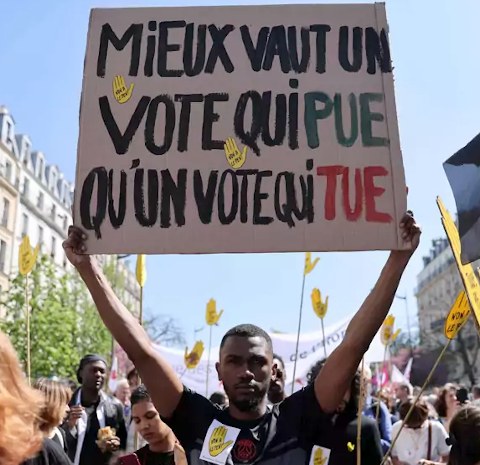
One reason for Le Pen’s defeat in the second round: enough people decided that the danger represented by the RN is grave enough to hold their noses and vote for Macron, thus in effect following a slogan from a mid-campaign rally: ‘better a vote that stinks than a vote that kills.’ Even though a greater proportion of people abstained or cast invalid ballots than in 2017, sufficient numbers of citizens came out to vote for Macron and block Le Pen’s path to presidential power. Indeed, according to pre-election surveys, Macron’s victory owes more to the anti-Le Pen vote than to support for his platform.
With important exceptions in zones where La France Insoumise voters tended to be divided (and in the overseas territories, including in Guadeloupe and Martinique, where many LFI voters switched to Le Pen for an astounding and contradictory range of reasons), this was also true for those who voted for Mélenchon in the first round. The bulk of the LFI voters that cast a valid ballot in the hexagone did so for Macron.
Macron and Le Pen: Adversaries in Need of Each Other
While just enough voters in 2022 ignored the abstentionist undertone of the 2017 slogan, the authors of “Macron 2017 = Le Pen 2022” were right at a deeper level. Macron’s and Le Pen’s respective political projects are joined at the hip. They are interdependent in ways similar to the ‘dancing duos’ – duelling camps of authoritarian neoliberals and the far and populist right – in other imperial, and thus comparably internationalized contexts (such as the US, Britain, Italy, Germany, and Canada).
The electoral campaign highlighted once more that each camp wants to make the other its main adversary. Macron’s project to unite French neoliberals committed to the European Union and NATO is the perfect foil for Le Pen’s project to join its far-right allies (including the current governments of Poland and Hungary) to supplant the European Union as we know it with a ‘Europe of Nations’ that would allow the French far right to wallow in its old frontist habits, mixing a Brexit-like nostalgia for French imperial grandeur with plain-old ethno-nationalism. Grooming each other as their principal opponent is convenient for each party also because it invites careless observers to forget that despite each camp’s attempt to replace the left-right divide with a distinction between ‘globalism’ and ‘nationalism’, each party is committed to a neoliberalized and flexibilized capitalism.
During his first term in office, Macron tried to have the cake while eating it too: cultivating Le Pen as an adversary while encroaching on her political terrain (as well as the turf carved out by the right-wing populist wing of the Républicains). After completing the task of marginalizing the Parti Socialiste by demolishing it at the polls twice in 2017 and absorbing some of its personnel into his La République en Marche, Macron was free to re-direct his trasformismo (Gramsci), as Thibault Biscahie details in a forthcoming doctoral dissertation.
In his first term, the President from Amiens transfigured his original centrist claims to govern from the right, deepening neoliberal reforms and – literally – beating back opponents of his social war, whether trade unionists, yellow vests, or anti-racist activists. Essential to Macron’s radicalizing neoliberalism: his (and his ministers’) efforts to do in select, crucial moments what the RN and the Républicains (as well as assorted Socialists) had been doing for years: painting ‘immigrants’, ‘communitarians’, ‘Islamo-leftists’, and, more recently, ‘wokeism’ as spectres haunting France.
The War of Position of the Front National
“There are at least 13 million people in France who are not disgusted by the [RN’s demand] for national preference,” — Laurent Lévy, Facebook post, April 24, 2022.
Macron’s first term demonstrates once more why any discussion of the “de-demonization” (dédiabolisation) of Le Pen’s project must take into account not only the Front National (FN) (renamed Rassemblement National, RN in 2018) but also the role of mainstream political forces in normalizing the far right. As long-standing specialist of the FN Nonna Mayer reminded us, this type of normalization has taken at least three forms: (1) electoral opportunism, making the FN a legitimate electoral force in order to build electoral power or divide the opposition, as practiced by the forerunners of the Républicains (the RPR) and the Socialists (PS) in the 1980s; (2) absorbing select far-right ideas and practices while in office, particularly on issues of security and migration (increasingly common since the 1990s); and (3) giving the FN a disproportionate media platform, either through a perverse fascination with its leaders or by turning the FN/RN into sparring partners like any other. In this context, we can see that Macron has systematized a long-standing and dangerous game of cultivating the far right as the main opposition while appropriating elements of its discourse and programme.
Of course, normalization by electoral entryism has been the main goal of the National Front from the start. The FN was set up as an electoral front for a smattering of small far right parties and groupings in 1972. At that time, a group of intellectuals that helped form the Front – “The Research and Study Group for European Civilization” (GRECE) – was convinced that in the hostile political climate of 1968, the only way forward for the neo-fascist right was to prepare for a long-term intellectual and organizational war of position. For them, a crucial element of this war of position was to frame classic fascist orientations in civilizational terms (yes, the very terms that we know not only from Sarkozy and Le Pen but also from Huntington, Putin, Modi and Erdogan). Given the crises and internal conflicts that have shaped the FN since it arrived on the electoral scene in the 1980s, this war of position could not be fought without interruptions and new beginnings. But it is still alive today, whether or not we call the RN neo- or post-fascist.
Since 2011, Marine Le Pen has deepened the FN’s long-standing ‘war of position’. She has selectively softened the image and the discourse of her father’s party without compromising its organizational autonomy or its programme (which still contains the transitional planks upon which to build an authoritarian capitalist state centred on the today unconstitutional ethno-racialized basis of ‘national preference’, e.g., explicitly differential citizenship), as journalists and strategists reminded us during the 2022 campaign. Key to Le Pen’s project has been to (1) supplant (not eradicate) her father Jean-Marie’s penchant for loud anti-semitism speech with the anti-Muslim racism aggressively mainstreamed by President Sarkozy’s discourse of ‘national identity’; (2) make the party attractive to women as much as men (playing with femo- and homo-nationalist themes when convenient); (3) solidify the working-class and plebeian side of the cross-class electoral base of the FN/RN (a party that remains a petty bourgeois party in its organizational core and composition), and, partly for this purpose; and (4) advancing a right-wing shift by rejecting, in classic fascist fashion, the very distinction between left and right.
Engaged in an infernal dance with the radicalizing bourgeois right and Macron’s ‘extreme centre’, Marine Le Pen’s party leadership has been very successful. Electorally, the RN has moved from one success to another throughout the 2010s. After electoral advances at local, departmental, and regional scales, the RN can now for the first time rely on a cadre of career politicians and administrators, many of whom have learned to follow party directives and avoid the kind of scandals that helped end the FN’s forays into municipal office in the 1990s. Often governing by stealth and implementing a selectively radicalized version of right-wing municipal politics (centred on policing, petty patronage, and central town/city gentrification), these cadres have held onto their new fiefdoms in the recent 2020 local elections. They can now be counted on to do what Marine Le Pen’s leadership has long hoped for: giving the party an air of administrative respectability – and political electability – during national-level campaigns.
Marine Le Pen’s national electoral campaigns have not yet generated major results (the RN has only 8 deputies right now). However, the presidential runs have helped build the party’s electoral pool. Qualifying for the second round of the presidential election has been crucial for this purpose. After growing her father’s vote in the 2002 run-off against Jacques Chirac (from 5.5 to 10.6 million votes in 2017, from 18% to 32% of the vote), Marine Le Pen garnered more than 2.7 million additional votes in 2022 (41.5%). Geographically, the RN vote is not the property of a singular social space. In 2022, it has deepened existing zones of strength while winning 30 of 77 départements (instead of only 2 in 2017) and half of France’s 35,000 municipalities (twice as many as in 2017). It thus continued to expand its voter base from the traditional Mediterranean South and the deindustrialized zones in the North and Northeast to other parts of the hexagone, increasing its vote share even in areas that are still the least receptive to its project: (1) central cities and inner suburbs of urban agglomerations; (2) the Northwest, including the Bretagne; and (3) less populated areas between major towns (notably in a belt stretching from the Southwest to the Southeast by way of the arid Massif Central). If in 2017 doubts about the capacity of the RN to win the electoral keys to the Presidential Palace were still appropriate, these doubts are now little more than naïve articles of faith.
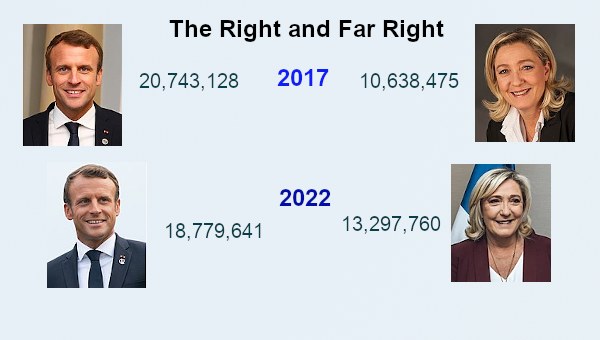
Between the Street, the Roundabout, and the Ballot Box: A New Dance?
Macron’s electoral victory took place on a terrain shaped by the comparative stagnation of French capitalism, the tectonic geo-political-economic shifts intensified by the war in Ukraine, and the socio-political rifts generated by the yellow vest movement, the COVID-19 pandemic, and its management. It is also built on the ruins left by Macron’s own success at splintering the party-political and electoral landscape through which political rule is, in part, organized. It is thus not clear that Macron’s extreme centre can hold in the mid-term, for his radicalizing neoliberalism permits no stable socio-political basis for his project to reorganize the composition of the ruling personnel. Weaving networks to expand the latter does not automatically generate the former, which explains why explicit support for his project remains minoritarian and programmatically shallow, pervasive common sense neoliberalization notwithstanding. In the electoral short term provided by the upcoming legislative elections, Macron’s project depends on his capacity to consolidate his alliance with the centre-right parties Modem and Horizons while poaching a cross-section of personnel from the imploding LR (including its Sarkozyist wing). Right now, these efforts do not face direct far-right competition: the RN and the LR have rejected Zemmour’s call to unite the right. Macron’s LREM and Le Pen’s RN will thus remain the crucial political rallying points for the centre and extreme right.
Is there a way to step out of the infernal dance between authoritarian neoliberals and far right ethnonationalists? At the level of presidential electoral politics, the short answer is a cautious ‘yes’. Jean-Luc Mélenchon’s La France Insoumise (LFI) came within 1.5% of reaching the second round of the presidential election, contributing to a tri-polar dynamic of political contestation achieved by mobilizing a ‘popular’ camp against both ruling-class neoliberalism and proto-fascism. While winning traditional left territories and scores of central cities across the country (as well as the massive Paris region Ile de France), Mélenchon also mobilized heavily abstentionist proletarian districts, garnering large pluralities or majorities in many postwar working-class suburbs as well as Martinique, Guadeloupe, and Guyana. Mélenchon pushed beyond left populism with this campaign, as well as a detailed left-social democratic economic-ecological programme and consistent anti-racist and anti-Islamophobic interventions that demonstrated the feasibility of what the anti-racist far left has demanded for decades: a political project gravitating around an alliance between those non-White and White working class segments that are not stranded on far-right shores. Having demonstrated this potential is already a victory of sorts. If it can be translated into advances during the June legislative elections remains to be seen and will depend partly on the result of negotiations between the LFI and other left parties.
Electoral strategies are, of course, fundamentally insufficient (as well as limiting). Breaking the political stranglehold applied by Macron and Le Pen is not imaginable without a broader dynamic of struggle, organization, and strategy. However, as we know not only from the yellow vest movement in France but also other recent mass mobilizations against pension reforms, ecologically destructive mega-projects, state racism, and police brutality, the prospects are weak for such a dynamic stand and fall with a capacity to tackle the manifold crises of political representation through which Macron’s and Le Pen’s projects flourish. There is not a single force on the left – neither the electoral LFI and its fledgling extension Union Populaire nor any other party, union, or movement – that has the organizational capacity to tie extra-parliamentary to parliamentary politics, link short-term campaigns to longer-term strategies, or, to put it in an updated version of an old slogan, connect the ballot box to the street and the roundabout. Ending the deadly dance of the extreme centre and far right thus requires an articulated plurality of efforts. This is also true if the left is to develop an emancipatory continental alternative to Macron’s and Le Pen’s respective projects, which rest on competing – and complementary – claims to Europe. •


